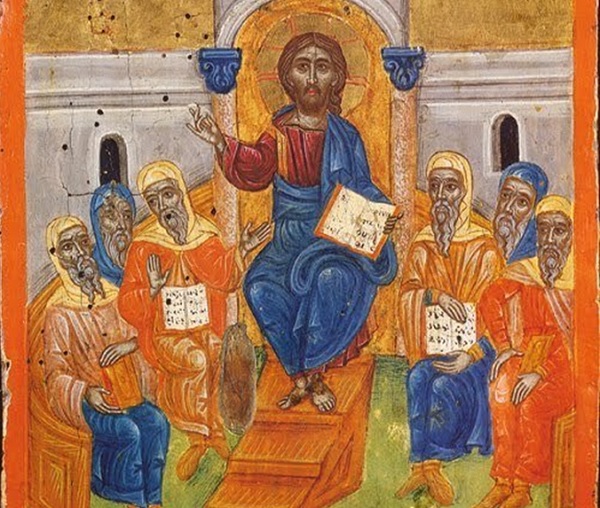At the Midpoint of the Feast…
19 May 2022[The Wednesday of the week after the Sunday of the Paralytic] is the feast of Mid-Pentecost, which marks the completion of exactly 25 days from Easter. That is to say, we’re half-way towards celebrating the feast of Pentecost.
In Byzantine times, the feast of Mid-Pentecost was the chief celebration of the Great Church of Constantinople and large crowds attended it. One need only open, at chapter 26, the Έκθεσις περί της βασιλείου τάξεως (‘Treatise on the Order of Ceremonies of the Realm’, usually ‘On Ceremonies’) by Emperor Constantine Porphyrogennitus, to see the formal order of service for the feast. ‘Half the days between the saving resurrection and Pentecost having passed, the brilliance of both shines and also present is the prospect of the glory of the Lord’s ascension’. In other words, without the day having its own particular theme, it links the themes of Easter and the descent of the Holy Spirit, while also giving a glimpse of the glory of the Lord’s Ascension, which will be celebrated in 15 days, that is, exactly 40 days after Easter.

[In Greek] the word for the midpoint between the two feasts sounds similar to the Hebrew word for Christ- ‘Messiah’. This is why the hymns and synaxari for the day make use of this false etymology, taking the opportunity to present Christ as the Messiah and intercessor between God and us [Mes-siah, mes-on, mes-itis]. Nikiforos Xanthopoulos remarks in the Synaxari: ‘The intercessor and mediator between us and his eternal Father… This is why we call the present feast Mid-Pentecost, naming Christ as the Messiah and praising him’.
The Gospel reading chosen for the day (Jn. 7, 14-30) contributes to the special character of the feast. Halfway through the Jewish feast of the Passover, Jesus went up to the temple courts and taught. His teaching was met with admiration but also with lively disagreement between himself, the people and the teachers. Was Jesus the Messiah or not? Was his teaching from God or not? So a new theme is introduced: Christ is a teacher. Although he’d never learnt anything formally, he had mastered the whole of wisdom, since he himself was the Wisdom of God*, who created the cosmos. A large number of the hymns of the feast are inspired by this dialogue. He who teaches in the temple, in the midst of the teachers and of the Jewish people, at the mid-point of the feast, is the Messiah, Christ, the Word of God. He who is disparaged by the allegedly wise men of the people is, in fact, the Wisdom of God. The Dismissal Hymn for the feast is well known: ‘Mid-way through the feast, refresh my thirsty soul with the flowing waters of piety. For you cried out to all, Savior, “Let those who thirst come to me and drink”. Christ our God, you are the source of life, glory to you’.
This, in general terms, is the feast of Mid-Pentecost. The truth is that the absence of any historical support (which the other feasts of the Lord all enjoy), has deprived it of the popular character that would have made it more generally observed. Its entirely theoretical and theological theme is of no assistance to Christians who don’t have the necessary theological background to break through the surface and delve deeper into the fêted glory of Christ the teacher and Messiah, the Wisdom and Word of God, the source of ‘inexhaustible water’ [cf. the exapostilario of the feast]. It would be good if we were able to grasp its great profundity and at least honor it by going to church on that day. Amen.
axrhstou.blogspot.com
*Churches dedicated to Holy Wisdom (Aghia Sophia) are actually dedicated to Christ.






